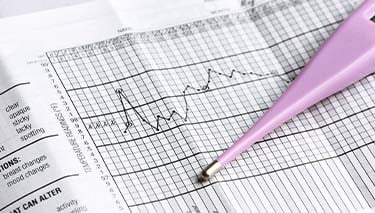One of the most significant indicators of the time of ovulation during your usual cycle is the ovulation temperature.
At the time of ovulation, your basal body temperature (BBT) will rise – and it will stay a little higher until menstruation.
The phenomenon of ovulation temperature has been a fairly reliable, low tech method for women to chart their normal ovulation cycle since early in the last century.
These days, you can purchase easy-to-use hormone test kits which give a definite indicator of whether you have ovulated.
However, the cost of the test kits can add up, particularly if you are using them over a number of months.
If you are on a tight budget and you are just trying to get an indication of your normal ovulation rhythm, charting your ovulation temperature can give you a good indication of when ovulation has occurred.
Why does ovulation temperature occur?
From adolescence until menopause, most women will experience a rise in their resting body temperature immediately after ovulation, which will remain at that level for the rest of the month.
Immediately after the egg has been released from the ovary, the empty follicle starts to produce a number of hormones designed to prepare your body for a possible pregnancy.
One of these hormones, progesterone, causes your basal body temperature to rise.
Towards the end of the regular cycle, your progesterone levels start to fall again, triggering menstruation.
What is basal body temperature – and how do you measure it?
When your body has been in a state of rest for a period of time, your core body temperature drops to conserve energy.
The best time to measure your basal body temperature is first thing in the morning, when you wake up, ideally before you get out of bed.
To chart your basal body temperature, use an accurate thermometer to take your temperature each morning before you get out of bed and record it manually.
There are a number of thermometers on the market specifically designed to measure your basal body temperature. The main feature of these thermometers is their ability to give accurate and detailed results.
However, the majority of standard digital thermometers will measure temperatures in increments of 0.05
Last Published* May, 2024
*Please note that the published date may not be the same as the date that the content was created and that information above may have changed since.





















